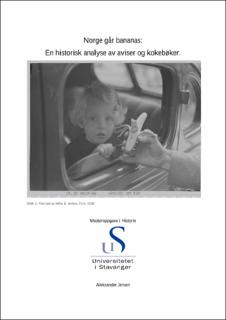| dc.contributor.advisor | Jørgensen, Dolly. | |
| dc.contributor.author | Jensen, Aleksander | |
| dc.date.accessioned | 2023-07-15T15:51:24Z | |
| dc.date.available | 2023-07-15T15:51:24Z | |
| dc.date.issued | 2023 | |
| dc.identifier | no.uis:inspera:146752593:36900225 | |
| dc.identifier.uri | https://hdl.handle.net/11250/3079206 | |
| dc.description.abstract | Denne oppgaven ser på hvordan den tropiske frukten, bananen, ble framstilt i norsk offentlighet siden den kom til Norge 1905 og fram til 1990. I den sammenheng ser oppgaven også på forbruk, forholdet mellom konsumenter og forbruksvarer, og hvordan dette forholdet stadig endrer seg.
Hovedproblemstillingen til oppgaven er: Hvordan ble bananen integrert i Norge mellom 1905 og 1990? Oppgaven etablerer også tre underproblemstillinger som bidrar til et grundigere svar på hovedproblemstillingen. De tre underproblemstillinger er: «Hvordan ble bananen framstilt i norske aviser og kokebøker?», «Hvordan hadde bananen kunne lykkes i Norge til tross for geografiske avstander til produksjonsland?» og «Hvordan hadde bananens egenskaper påvirket fruktens suksess i Norge?».
For svare på problemstillingen støtter oppgaven seg på et teoretisk ramme som tar utgangspunkt i forbruksteorier og reklame. Publikasjonene til David Stearns, Jean Baudrillard og Christine Myrvang er sentrale for dette. Oppgaven bygger på metodologi fra Minds in Matter av Jules David Prown med et fokus på selve objektet. Datamateriale til oppgaven har vært norske avisartikler og kokebøker (samt husstellbøker) fra 1905 til 1990. Kildene har blitt hentet fra det digitale arkivet til nasjonalbiblioteket.
Ved å analysere og se på utvalgte avisartikler og kokebøker mellom 1905 og 1990 har oppgaven funnet at bananen ble integrert gjennom vedvarende omtale i norsk offentlighet. Den drivende kraften bak den vedvarende omtalen var treffende og kontinuerlig markedsføring. Fruktens materielle og ikke-materielle egenskaper blir trukket fram som avgjørende i markedsføringen. Til tross for at bananen går fra å være en eksklusiv tropefrukt til en alminnelig hverdagsfrukt i Norge, avtar derimot ikke markedsføringen.
Oppgaven bidrar historiografisk innen materiell kulturell historie ved å studere hvordan en forbruksvare har blitt introdusert i nytt marked og etablert seg som dagligdags over en lengre periode. Den vil videre ha bidratt til å kartlegge bananens rolle i Norge, og hvordan framstillingen av frukten har speilet det norske samfunn. | |
| dc.description.abstract | This thesis examines how the tropical fruit, the banana, was portrayed in the Norwegian public since its arrival in 1905 to 1990. The thesis also looks at consumption, the relationship between a consumer and the object of consumption, and how this relationship continually changes.
The research question that was established is: How did the banana integrate in Norway between 1905 and 1990. The thesis also make use of three sub-questions with the purpose of providing a more detailed answer to the research question. The three sub-questions are: “How was the banana portrayed in Norwegian newspapers and cookbooks?”, “How could the banana succeed despite Norway’s distance to the tropical countries of production?” and How had the bananas attributes impacted the fruits success in Norway?”.
In order to answer the research question, the thesis relies on a theoretical framework that is based on consumption theories and advertising. The publications of David Stearns, Jean Baudrillard, and Christine Myrvang are central to this. The thesis also builds on the methodology of Minds in Matter by Jules David Prown with a focus on the object itself. The data material for the assignment has been Norwegian newspaper articles and cookbooks (as well as household books) from 1905 to 1990. The sources have been obtained from the digital archive of the National Library.
By analysing and looking at selected newspaper articles and cookbooks between 1905 and 1990, the assignment has found that the banana was integrated through persistent coverage in the Norwegian public sphere. The driving force behind this coverage was accurate and continuous marketing. The material and non-material properties of the fruit are highlighted as crucial in marketing. Despite the fact that the banana goes from being an exclusive tropical fruit to a common everyday fruit in Norway, the marketing campaign does not decrease.
The thesis contributes to historiography in material cultural history by studying how a consumer good has been introduced into a new market and established itself as an everyday item over a long period. It will further have contributed to mapping the role of the banana in Norway, and how the portrayal of the fruit has mirrored Norwegian society. | |
| dc.language | nob | |
| dc.publisher | uis | |
| dc.title | Norge går bananas: En historisk analyse av aviser og kokebøker. | |
| dc.type | Master thesis | |
